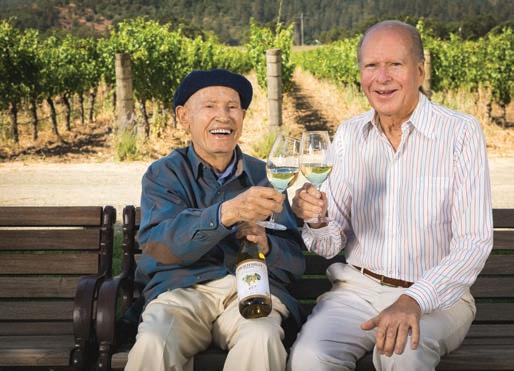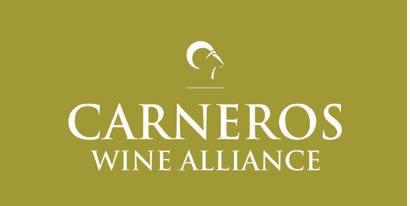
10 minute read
Magna Carta Cellars
Where Harmony = Art + Science + Hope


BY LAURIE JO MILLER FARR
Catchy name, right? For those who know their history, the year 1215 was an important one in writing the charter of liberties. In Runnymede, a small meadow on the banks of the River Thames not far from London, a parchment drawn up in Latin and signed by King John changed everything.
Eight centuries later, that place and that moment, now known as "the birthplace of modern democracy," was the inspiration for David Choi, proprietor, in naming Magna Carta Cellars in Napa Valley. "I love creating something original. There's nothing formulaic going on here. For my amazing partners and me, it's the art, the stories, and the people that go into what we make together from the phenomenal grapes that Napa produces." Choi is proud to work in harmony alongside skilled winemakers Peter Heinz and Scott Palazzo, on a team he says are "in sync with the vision of a top-level Bordeaux wine profile."
A deep love and respect for Bordeaux have played an important role in David Choi's life. In 2012, he was inducted into Jurade of Saint Emilion, the region's oldest wine society. He was later awarded "L'Ordre du Mérite Agricole" by the French Ambassador and the Republic of France for his important work with French wines, French winemakers, and the notable terroir. As there are only 60 living U.S. recipients of this distinction that traces its origins to 1883, he explained more about the journey that led him to receive this honor.
Determining early on that continuing in an investment banking career was not the right path, Choi stumbled upon his happy place. It turned out to be Pearson's Wine & Spirits, established in 1933, a highly reputable Washington, D.C. wine shop. Eventually, his family acquired the business and roster of loyal customers who wanted to learn more about good wine. As a wine merchant, importer, and wholesaler enamored of high-quality French wines, Choi regularly traveled to the source vineyards, connecting with legendary winemakers, forming friendships, and then showcasing the wines in major cities across the USA.
Choi has always been driven by intellectual curiosity and the natural gift of a very good palette. "I was tasting 30 to 40 wines per day. Much as I loved it, at one point, I realized that I was not going to be a retailer forever."
Leaving Pearson's in good hands, Choi returned to his native California, where he believes Napa promises "world-class, phenomenal grapes." For Magna Carta Cellars, these are carefully selected from among the finest vineyards in Oakville, Carneros, and Stags Leap, which Choi defines as "very, very strong for Left Bank-style Cabernet-based wines that resemble the best of Bordeaux and can be launched in just four to five years." As for 2021, "We're always at the mercy of the grapes, said Choi. "That’s where the hope comes in.”

Expanding the Horizons with Napa Valley CHARDONNAY
BY CHRIS SAWYER
It was like a shot heard around the world when the 1973 Chardonnay crafted at Chateau Montelena Winery in Calistoga received the top score over top White Burgundy selections from France at the famed Judgment of Paris tasting held on May 24, 1976. On this day, the path of the California wine industry changed for good.

Chateau Montelena 1973 Chardonnay Photo by Susanna Blåvarg

Decades before this iconic wine was created, a unique series of cuttings from France were planted at the Wente Vineyards in Livermore Valley in 1912. The Wente family’s ongoing dedication to meticulous growing methods and breakthrough vine treatments elevated their Chardonnay clones to become the industry standard. Today, they represent over 75 percent of the Chardonnay grown in all of California.
Inspired by their love for Burgundy’s cherished white wines, Fred and Eleanor McCrea were among the early pioneers to plant the Wente clone of Chardonnay on the hillside property they purchased on Spring Mountain west of Saint Helena in 1948. In 1952, they began bottling the varietal under the Stony Hill label. In doing so, they joined Hanzell Vineyards in Sonoma, Ridge Vineyards in Santa Cruz Mountains, and a handful of other early producers focused on making world-class wines with Chardonnay grapes planted at high-elevation sites in the 1950s and 60s.
Before the Paris tasting happened in 1976, the white grapes grown on the valley floor were primarily Chenin Blanc and Riesling. For that reason, Chateau Montelena founder James Barrett and winemaker Mike Grgich made the famous 1973 vintage with Chardonnay grapes purchased from the Bacigalupi Vineyard in the Russian River Valley region of Sonoma County and local vineyard sites located in Calistoga and the Oak Knoll area near Napa. Modeled after the sophisticated Meursault wines of Burgundy, the grapes were harvested when the ripe flavors were balanced. The minimalist, “hands-off”

Judgment of Paris Photo by Bella Spurrier
approach in the cellar included aging the wine for eight months in mainly neutral barrels and only 10% new oak.
The Barrett family and Grgich were on to something, as proven by the high scores the wine received from the distinguished panel of French judges who, along with Paris-based British wine merchant Steven Spurrier (who organized the tasting), were all shocked at the final results. When journalist George Taber’s story about the triumph of American wine appeared in Time magazine the following week, it caught the attention of a new breed of rising star vintners, growers, and winemakers who helped lead the movement of widespread Chardonnay plantings, increasing the state total from 2,700 in 1970 to 45,000 acres by 1988.
While celebrating the 40th anniversary of the Judgement of Paris in 2016, Grgich said an important lesson he learned from the victory was, “You don’t need French soil to make great wine.” To continue this legacy, Grgich partnered with Austin Hills, of the Hills Bros Coffee Company, to found the Grgich Hills Cellars in Rutherford.
One of the early fans of the Chardonnays bottled under the Chateau Montelena and Grgich Hills labels is wine writer and reviewer Wilfred Wong, who first discovered the brands while managing the wine selections at his family’s Ashbury Market in San Francisco during the late 1970s. Today, as the Chief Storyteller for Wine.com, Wong said the Grgich Hills wines are in a class of their own.


“Bright with aromas and flavors of green apple, mineral notes, and chalk, this wine stretches the palate and offers the opportunity to experience Chardonnay in the purest of forms,” commented Wong, on the profile of the 2018 Estate Chardonnay, which was included on his Top 10 list in 2020.
On a similar wavelength, second-generation Chateau Montelena proprietor Bo Barrett and winemaker Matt Crafton have continued to increase the quality of the white wines they grow by putting more emphasis on the special Chardonnay blocks they began developing in the Oak Knoll District in the late 1970s. “Every time we release a wine, we want people to want to come back for more and want that second sip, a second glass, and ultimately a second bottle and follow our brand from that point on,” said Crafton, who joined the team in 2008.
Another significant contributor is Stuart Smith, who planted Chardonnay vines at Smith-Madrone Winery on Spring Mountain in 1972. Today, Smith, his brother Charles and son Sam continued to fine-tune the process of making world-class wines, first, by planting a series of new vineyard blocks in 1986 and picking the grapes at a lower degree of sugar. In the cellar, they use yeasts that help slow down the fermentation process, barrel-age in fine-grained French oak, and keep oxygen away from the wine while it matures, preserving the expressive flavors naturally abundant in the grapes grown between 1,300 to 2,000 feet elevations. The result is a premier wine that represents a true expression of site and vintage inside each sip.

Smith Madrone Vineyards Wine legend Mike Grgich and partner, Austin Hills

CHARDONNAY EXPANSION IN CARNEROS
Today, the largest concentration of Chardonnay forms the gateway to the Napa Valley region of Carneros. Harnessed by the San Pablo Bay to the south and the Mayacamas Mountain range to the north, this unique geographical area connects Napa and Sonoma’s southernmost part. The terroir is known for its calcium-rich clay soils and cool maritime growing conditions moderated by foggy mornings and windy afternoons. As a result, the clusters have time to slowly develop complex flavors while still retaining plenty of natural acidity before harvest.
Three of this area’s original visionaries include Larry Hyde, Lee Hudson, and Andy Beckstoffer. Larry Hyde, who was recently awarded 2020’s “Winegrower of the Year” by The Napa Valley Grapegrowers, is known for developing the expressive Wente-Hyde clone in the late 1970s. The clone is now used to create a natural “chicks and hens” medley of flavors based on each cluster’s individual berries’ size. Lee Hudson began developing special blocks of Chardonnay in 1981. Today, the fruit is used to produce “The Judge,” an elite Chardonnay crafted by legendary winemaker John Kongsgaard, a flavorful wine from PlumpJack Estate Winery in Oakville, and Hudson Ranch, a boutique wine from his family label. Andy Beckstoffer, acclaimed for his impressive collection of premier vineyard sites throughout California, owns the 44-acre Carneros Creek Vineyard and the 480-acre Carneros Lake and Las Amigas Vineyard properties. These vineyards provide world-class Chardonnay grapes to all-star vintners such as Darioush Winery, Frank Family, Newton Vineyard, and Stag’s Leap Wine Cellars.
On Buchli Station Road, Bouchaine Vineyards is the oldest operating winery in the region. Originally bonded as Garetto Winery in 1934, Beringer later owned the historical site before it was purchased and renamed by Gerret and Tatiana Copeland
in 1981. Today, the team lead by head winemaker and general manager Chris Kejani offers a wide array of high-quality Chardonnays that run the gamut from crisp and fruity to opulent, complex, and age-worthy.
While the flavor profiles differ based on where the vines are planted at the estate, they all share tart and tangy characteristics that have become a trademark of the Carneros appellation.
For those who prefer the rich, round, and buttery styles, Carneros is also home to the classic Rombauer Chardonnay, which the winery has been making since 1990. At the corner of Duhig and Las Amigas Road is the original home of Acacia Winery, founded in 1978, which has since become the exciting new epicenter for Calmere, a boutique brand started by second-generation wine country family members Lisa and Ariana Peju. When visiting the region, other great opportunities to taste a wide range of stylish Chardonnays are available at Truchard, Saintsbury, Etude, Cuvaison, Donum Estate, and Sangiacomo Vineyards.
Beyond still wines, a percentage of Chardonnay grapes grown in Carneros are harvested for sparkling wines. Peter Molnar of Poseidon Vineyards said his parents originally developed the 100-acres near the Napa Marina in 1973 to provide grapes for Domaine Chandon through the mid-1980s. Since then, the Chardonnay fruit has been sold to Mumm Napa, Schramsberg, Pride Mountain, and bottled separately under the family’s Poseidon Vineyards label.
“In a nutshell, Carneros is a small group of winegrowers and vintners without a lot of egos,” said Molnar. “Instead, it’s a shared passion to produce higher-quality Chardonnays and preserving the integrity of the natural elements that make this region so special.”
From delighting the sense with alluring aromas and exquisite flavors to creating memorable food pairings: Napa Valley Chardonnay offers opportunities to explore all year long.

Chateau Montelena, Chief Operating Officer Bo Barrett and Winemaker Matt Crafton Chardonnay grapes Photo courtesy of Rombauer Vineyards



The Carneros AVA is unique for our cool climate which provides the perfect growing conditions for Chardonnay and Pinot Noir. On behalf of all our member wineries and growers, we wish everyone the best in the new year ahead and we hope to see you all again soon.











